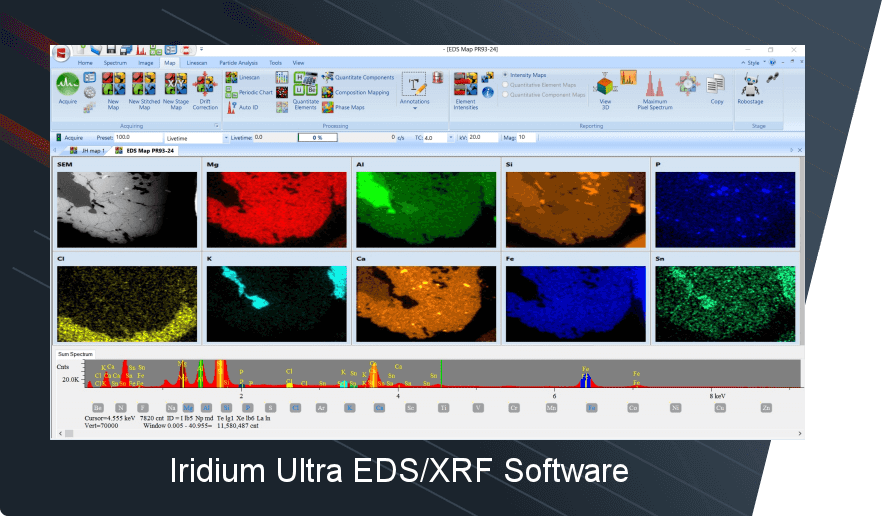Shark teeth, both ancient and modern, provide valuable records of environmental, ecological, and evolutionary changes over time. Micro X-ray fluorescence (microXRF) spectroscopy, with its high spatial resolution and broad elemental coverage, offers an effective method to study these fossils and contemporary samples. Researchers can unlock important insights across multiple disciplines by comparing the elemental composition of fossilized and modern shark teeth.
Tracking Environmental Changes Over Time
Researchers can assess how ocean chemistry, temperature, and pollution levels have evolved over millions of years by analyzing differences in elemental composition between fossilized and modern shark teeth. This comparison helps pinpoint major events in Earth’s history, such as climate changes, ocean acidification, and fluctuations in metal concentrations. MicroXRF’s capability to detect elemental variations with high precision makes it an ideal tool for tracing these long-term changes.
Assessing Evolutionary Adaptations
Comparing fossilized shark teeth to modern ones reveals how sharks have adapted to different environmental conditions over time. Elemental differences can reflect changes in diet, habitat preferences, and responses to environmental pressures like sea-level shifts or prey availability. MicroXRF analysis supports these studies by providing detailed data on trace elements and isotopic ratios, offering evidence of evolutionary shifts.
Understanding Dietary Shifts
Elemental analyses, such as those of trace elements like strontium and zinc isotopes, offer insights into shark diet and trophic levels. By comparing fossilized teeth with modern samples, researchers can explore how shark diets have evolved due to changes in prey availability, competition, and ecosystem structure. MicroXRF’s ability to map these elemental variations allows for precise tracking of dietary shifts across time periods.
Identifying Anthropogenic Effects
The comparison of modern shark teeth with fossils also enables researchers to detect the impact of human activities on marine environments. Elements indicative of industrial pollution or newly introduced chemical compounds can be measured and compared to historical baselines established from fossils. This helps to evaluate the extent of anthropogenic changes in marine ecosystems over recent centuries.
Reconstructing Past Oceanographic Conditions
The elemental makeup of shark teeth, including ratios of oxygen, carbon, and strontium isotopes, is a proxy for reconstructing ancient oceanographic conditions. By comparing these data points from fossilized and modern teeth, researchers can better understand how oceanic changes, such as shifts in temperature, salinity, and water chemistry, have influenced shark populations over time.
Insights into Biomineralization Processes
MicroXRF analysis of shark teeth offers valuable data on biomineralization processes. By studying how the incorporation of elements into tooth structures has changed over time, researchers gain insights into the biological processes governing the formation of hard tissues in marine species. This information helps us understand how environmental conditions impact biomineralization and the long-term health of marine organisms.

Figure 1: False-color 2D microXRF maps of shark tooth fossil showing P, S, Fe, and Nd distribution in fossil. Data was collected with the Atlas X microXRF using a 10 µm spot size.

Figure 2: False-color 2D microXRF maps of modern shark tooth showing P, S, Fe, and Nd distribution in the tooth.
A Comprehensive View of Marine Ecosystem Changes
By leveraging comparisons between fossilized and modern shark teeth, microXRF spectroscopy offers a clearer picture of historical and current marine ecosystems. This knowledge helps researchers understand how sharks and other marine life have responded to past environmental changes and how they might react to ongoing and future shifts.
Acknowledgment
We sincerely thank Professor Alberto Perez-Huerta from the University of Alabama’s Department of Geological Sciences for providing the shark teeth specimen samples and collaborating with us on this important research. His expertise and support have been invaluable in advancing our understanding of marine ecosystems through microXRF spectroscopy. We are honored to work alongside Professor Perez-Huerta and his team to uncover the secrets embedded in these extraordinary samples.
At IXRF Systems, our microXRF technology supports detailed and precise elemental analyses, empowering researchers to make new discoveries about the complex history and current state of marine ecosystems. Contact us today for more information on how microXRF can enhance your studies.


